Amazon S3 Transfer Acceleration and AWS Global Accelerator can both help you improve the performance of your web applications, especially if you have widely distributed users spanning the globe.
S3 Transfer Acceleration helps speed up long-distance object transfers between S3 buckets, while Global Accelerator helps manage traffic across multiple AWS regions. In this guide, we’ll explain the key differences between these services so you can understand which one is right for you.
However, before we dive in, it’s also worth noting that both Amazon S3 Transfer Acceleration and AWS Global Accelerator have some limitations that can’t be avoided. Mainly:
- Their data transfer speeds are limited due to their use of point-to-point transfers and TCP.
- They add complexity to your AWS service stack, which can make it much more difficult to manage and estimate your cloud costs.
- They’re limited to the AWS ecosystem. You can’t use either of these services to transfer data or manage traffic to other clouds (and in the case of S3TA — to other services besides S3).
That’s why, in the second part of this guide, you’ll learn how Resilio Connect — our WAN-optimized data transfer, sync, and file gateway solution — can help you get many of the benefits of S3TA, Global Accelerator, and other AWS services (like S3 Replication) in a much simpler and cost-effective way.
In short, we’ll show you how Resilio Platform can help your organization:
- Optimize data transfer, sync, and replication speeds across any global AWS region or service (or use any storage for any cloud provider). Resilio Platform lets you transfer files of any size and type across any number of endpoints located anywhere in the world. Our software’s P2P architecture and WAN optimization technology ensure you can do this with near-zero latency to keep files current in real-time across as many endpoints as needed. You can even use Resilio Connect in combination with Global Accelerator to achieve extremely fast redirection between or across regions.
- Control all aspects of data transfer, replication, file routing, file access, security, and more from a single place. Resilio’s Management Console lets you centrally manage all aspects of file transfer and sync jobs through an easy-to-use console. You can set bandwidth priorities for agents, control and monitor performance, and set notifications.
- Get full deployment and data transfer flexibility. Resilio Platform lets you use any cloud provider (or a combination of providers). You can use our software to ingest data into the Amazon Web Services cloud, move it across regions and services, and transfer it to other providers like Azure and GCP, as well as on-prem storage and hybrid cloud environments.
Companies in industries like gaming (Blizzard), media (Warner Brothers), and digital communications (Cisco) have used Resilio to achieve high-speed, reliable data transfer, sync, and replication. Click here to book a demo with our team.
S3 Transfer Accelerator vs Global Accelerator: An Overview of Pros, Cons, and Use Cases
S3 Transfer Acceleration (S3TA) speeds up long-distance uploads and downloads to S3 buckets. It’s an S3-specific feature, meaning it’s not relevant in the context of other AWS services, like Amazon EC2, for example.
S3TA automatically routes data through the closest AWS edge location using the Amazon CloudFront content delivery network and various network protocol optimizations. This speeds up transfers and avoids many of the issues that come with moving data over the public internet.
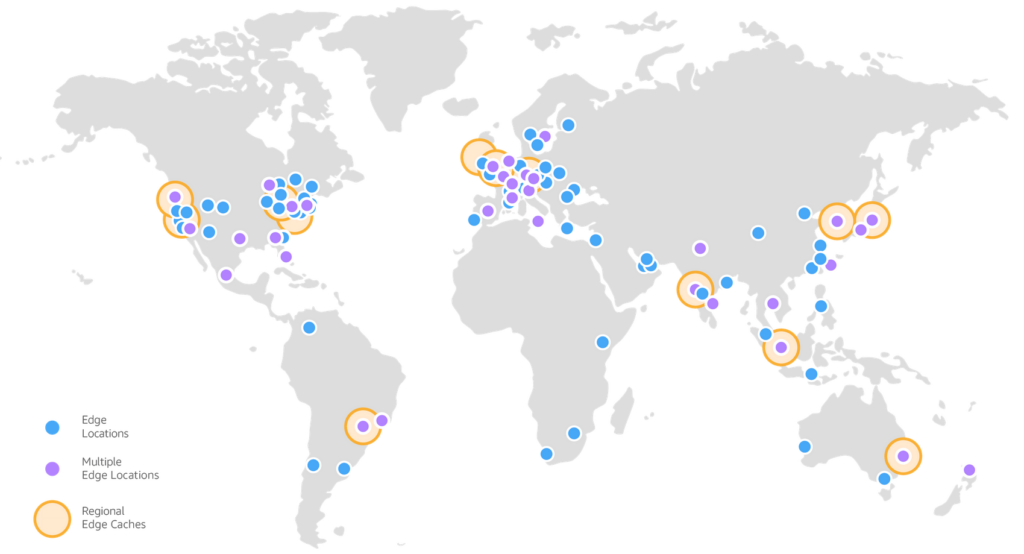
This makes S3TA a good choice for organizations that:
- Have on-prem apps in distributed locations and use the S3 API to store data in a centralized bucket.
- Have S3-powered apps and have end users distributed all over the globe.
- Regularly transfer high volumes of S3 data between countries.
Note: You can learn more about this feature in our Ultimate Guide to S3TA.
AWS Global Accelerator is a networking service that provides two fixed IP addresses to act as a fixed entry point to your app endpoints (like application load balancers, network load balancers, and EC2 instances).
Like S3TA, this service also relies on the global network of AWS to deliver more consistent performance, compared to routing traffic over the public Internet. However, Global Accelerator isn’t focused on transferring data between S3 buckets. Instead, its main purpose is to distribute traffic across multiple AWS regions.
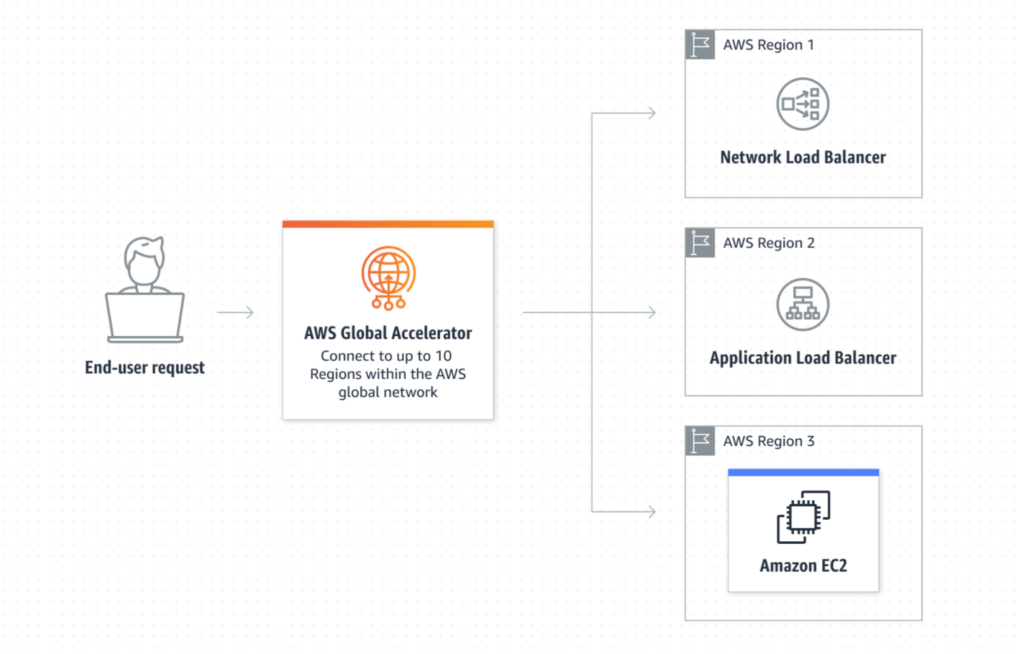
This makes it a good choice for organizations that:
- Want to manually route traffic to the nearest AWS region or achieve fast failover across regions (unlike S3TA which routes traffic automatically and doesn’t cover the failover use case).
- Want to use custom routing to deterministically route traffic to a fleet of EC2 instances (which is especially useful in the media and gaming industries).
- Have enterprise firewall setups or IoT use cases and want to simplify allowlisting.
Since S3TA and Global Accelerator serve different needs, they’re not mutually exclusive. In fact, organizations often use them together, alongside other AWS services — like S3 Replication, AWS Snowball, and AWS Direct Connect — to ensure fast data transfers, maximum bandwidth utilization, and app reliability.
The Limitations of S3TA and Global Accelerator
While S3TA and Global Accelerator are both useful services, they have some inherent limitations that can’t be avoided:
- Pricing unpredictability due to complexity. As we said, companies often use a myriad of AWS services to transfer, replicate, and sync their data quickly and efficiently (on top of other services like Lambda, VPC, Route 53 DNS, and RDS, for example). This makes the setup and management process incredibly complex. It also leads to pricing uncertainty, as each service comes with its own unique pricing, on top of the regular AWS egress fees and data transfer charges.
- Limited data transfer rates. S3TA and Global Accelerator rely on a point-to-point (client-server) model and use TCP for all transfers. As a result, the speed of each transfer is limited by the throughput between each endpoint. Plus, TCP often struggles with long-range transfers due to latency and packet loss. The client-server model also has a single point of failure, so one server going down can stop data transfer, sync, or replication across the entire environment.
- Vendor lock-in. S3TA and Global Accelerator are built to keep users within the AWS cloud. You can’t use them to move data or manage traffic across other cloud providers without buying separate software or spending lots of engineering hours on building your own tools.
In the next sections, we’ll show you how Resilio Platform can help you overcome these limitations.
The Benefits of Using Resilio Connect
Resilio Platform is an agent-based, software-only solution that organizations use to:
- Achieve lightning-fast data transfer, sync, and replication. Our solution is typically between 3-10x faster than other tools, thanks to its P2P architecture and proprietary UDP-based WAN optimization technology that delivers the fastest transfer speeds across locations over any distance.
- Handle massive data workloads, like transferring many large files to thousands of endpoints all over the world.
- Remotely browse and manage transfers and data flows from a single, unified management console.
- Synchronize web and app servers.
- Backup files from remote offices.
- Distribute software builds.
- And much more.
Resilio Platform is also a vendor-agnostic solution. You can deploy it directly on your endpoint devices — like cloud instances, mobile phones, desktops, and servers — and manage everything from a user-friendly Central Management Console.
Below, we’ll discuss four benefits of using Resilio Platform over S3TA and Global Accelerator (or in some cases — as an addition to Global Accelerator) to transfer, sync, and replicate data.
1. Speed & Organic Scalability
There are two fundamental challenges with the data transfer methods used by S3TA and Global Accelerator:
- They’re point-to-point (aka client-server).
- They’re TCP-based.
When using a client-server model, one device acts as a hub that can receive and share data with any of the other devices. However, the clients can only share data with the hub and not with each other.
As a result, the hub is a single point of failure and the whole process becomes reliant on cloud hopping, as data has to go through Client 1 to the hub, instead of just going from Client 1 to Client 2. Plus, the hub can only transfer data to one client at a time, so if one device has an outage, slow network, or another issue, the transfer to all other devices can be obstructed.
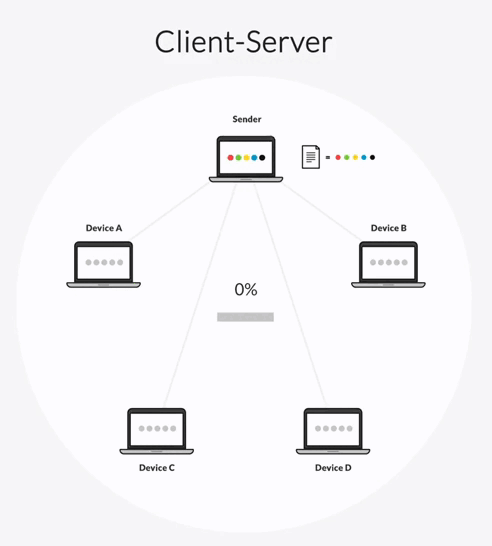
The second issue has to do with the use of the TCP protocol for long-range data transfers.
TCP works well for Local Area Networks (LANs) but struggles due to a number of factors when operating over distance, as even small levels of latency and packet loss degrade its performance. As a result, companies often can’t make the most out of expensive Wide Area Networks (WANs) and transfer data quickly all over the globe.
Fortunately, Resilio Connect’s unique P2P architecture and proprietary WAN optimization technology can help you overcome these issues.
P2P Architecture: Speed, Built-In Scalability, and Reliability
Resilio Platform uses a unique P2P (peer-to-peer) architecture that lets all servers in your environment share data with each other. In other words, every server can act as a hub, which drastically speeds up data transfer and replication speeds.
Resilio Platform also separates files into pieces and transfers them independently of each other (a process called “file chunking”).
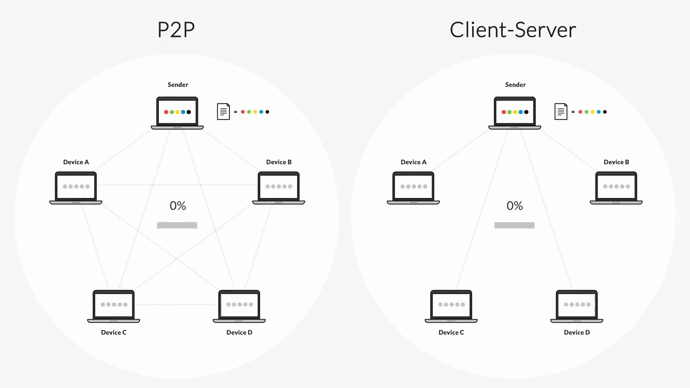
This combination of capabilities results in 3-10x faster transfer speeds compared to traditional point-to-point solutions. It also enables Resilio to sync and replicate data in any direction:
- One-to-one
- One-to-many
- Many-to-one
- Two-way
- N-way (aka many to many).
The N-way capability in particular makes Resilio Platform ideal for syncing large numbers of servers, as every server can sync across the entire environment. It’s also great for remote work collaboration because anyone can share file changes with others instantly, regardless of their location.

Besides being faster, Resilio’s P2P architecture also scales much better than traditional solutions.
With client-server environments, performance often degrades when you add endpoints and try to move large volumes of data over long distances. Additionally, scaling up these environments is costly, because you need to:
- Buy more hub servers as you add more clients.
- Constantly find ways to balance the network load between the hubs.
Resilio Platform is an organically scalable solution, so the more servers you add, the better it performs. For example, Resilio can synchronize data 50% faster than point-to-point solutions in a 1:2 scenario and 500% faster in a 1:10 scenario.
Lastly, the P2P architecture makes Resilio Connect ideal for disaster recovery scenarios because it doesn’t have a single point of failure.
Our software can automatically route around outages and retrieve data from the nearest available device. As a result, data is always retrieved as fast as possible, enabling organizations to meet sub-five-second RPOs (Recovery Point Objectives) and RTOs (Recovery Time Objectives) within minutes of an outage.
Resilio can be used in different disaster recovery (DR) scenarios, like:
- Cold DR
- Warm-site DR
- Offsite copy
- Hot-site DR
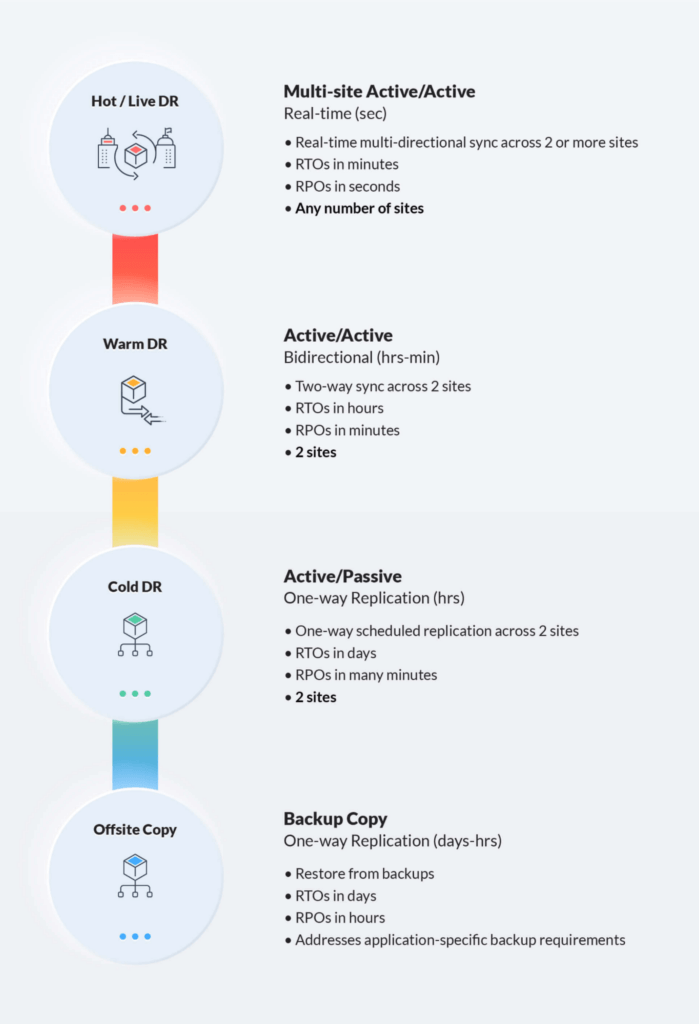
Thanks to its versatility, Resilio Platform can also be used in combination with Global Accelerator.
For example, say you have file servers in one AWS region and want to sync them across another region. Resilio Platform can help you do that in real-time and achieve sub-five-second RTOs (which means you get “hot active” copies of your data in both regions).
From here, you can rely on Global Accelerator to balance users to either of the regions, depending on your needs. If one region goes down, Global Accelerator can send traffic to the other one, while Resilio continues to keep files synced on the back end. As a result, you get extremely fast redirection between or across regions, resulting in very low recovery times.
WAN Optimization: Reliable and Fast Long-Range Data Transfer
Instead of using TCP, Resilio Platform relies on a proprietary UDP-based transfer protocol called Zero Gravity Transport (ZGT™). This protocol is designed to maximize transfer speed across any network and overcome the impact of latency and packet loss.
ZGT does this by:
- Using a congestion control algorithm: This algorithm periodically probes the time it takes for the destination to receive a packet (i.e., the Round Trip Time or RTT). As a result, our software can maintain a uniform packet distribution rate by using a fixed packet delay.
- Sending out interval acknowledgements and reducing unnecessary retransmission: Resilio Platform sends out acknowledgements after receiving a group of packets (instead of after receiving each packet, like most transfer solutions). It also retransmits lost packets once per RTT to reduce unnecessary retransmissions.
Put simply, Resilio Platform gives you a proprietary WAN optimization technology for all of your data transfer needs — including ingestion, distribution, synchronization, and cross-region replication — regardless of your cloud region, cloud provider, and storage solutions.
You can also use our speed calculator to estimate how much time Resilio can save your organization, depending on your use case.
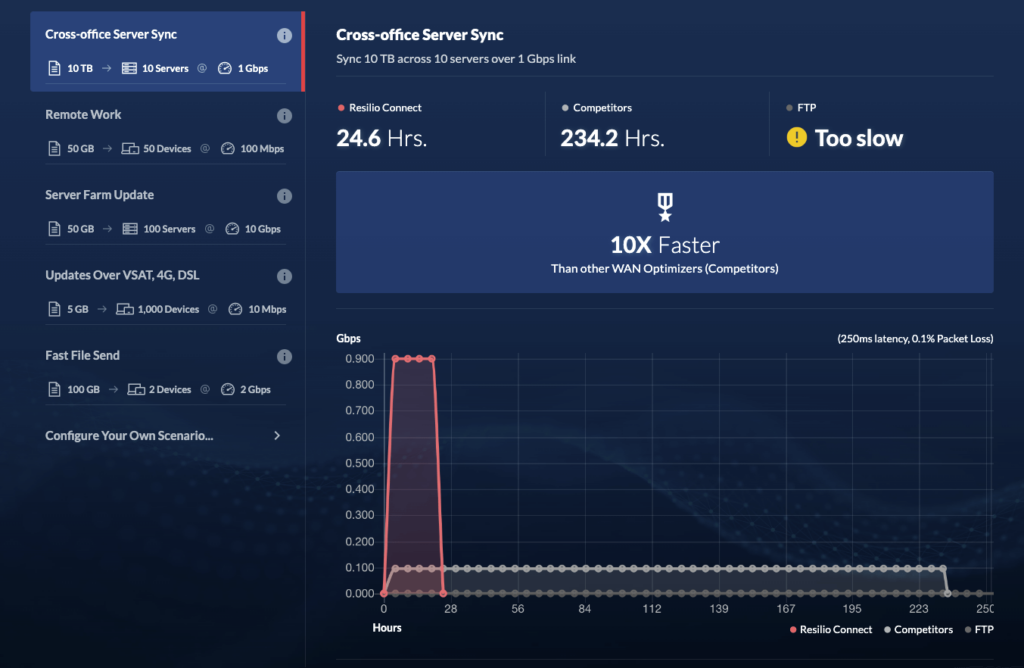
For real-life examples of the power of our P2P architecture and WAN optimization technologies, check out the three case studies below:
- Turner Sports uses Resilio Connect to sync the files on the local server in the media truck to their SAN in Atlanta via a WAN.
- Mixhits Radio uses Resilio Connect to consistently deliver high-quality music experiences to its customers across the US.
- One of the world’s largest marine construction companies uses Resilio Connect on 30 of its vessels to guarantee high-speed data transfers from shore to ship and back.
2. Deployment Flexibility & Simplicity
Unlike S3TA, Global Accelerator, and all proprietary AWS storage services, Resilio Platform is a multi-cloud solution that builds on open standards and open file formats.
This means you can:
- Deploy Resilio on your existing IT infrastructure and storage, including industry-standard, servers, networks, desktops, NAS, DAS, SAN, and more.
- Run it on popular operating systems such as Windows, Android, macOS, a variety of Linux distros, FreeBSD, and more. Resilio also runs on popular virtualization platforms like VMware Citrix, and Microsoft FSLogix.
- Blend storage from any type of cloud computing provider, platform, or object storage. For instance, you could use S3 on one endpoint and Azure Blobs on another or have JBODs with hard drives or SSDs.
- Use any type of storage interface — file, block, or object.

Thanks to this versatility, Resilio Platform lets you build in any cloud, on-prem, or hybrid cloud environment. There’s no vendor lock-in — you can quickly create and tear down projects in any cloud.
For example, you can use Resilio to:
- Ingest your data into AWS and transfer it across S3 buckets (including different storage classes) and other services. Again, the software’s unique P2P architecture and WAN optimization technology ensure low latency regardless of the distance between endpoints.
- Transfer and sync data across other cloud providers — including Azure, GCP, Wasabi, Backblaze, and many more.
- Use any mix of hybrid and on-prem storage, like DAS, NAS, or SAN.
Put simply, you can use our software to ingest, move, and replicate data across any region, service, or cloud provider.
All this is controlled only from a Central Management Console, which makes the setup and data management much easier, especially in multi and hybrid cloud scenarios.
On that note, the Console gives you a simple, user-friendly way to manage each aspect of your data transfer, sync, and replication. For example, you can use it to configure:
- Replication, transfer, and sync jobs.
- Parameters like buffer size, disk IO, and more.
- Real-time notifications of file transfer progress (sent via email or webhooks).
As shown below, the console also lets you monitor your work by reviewing scheduled and executed jobs, collecting transfer logs, troubleshooting errors in real-time, tracking metrics like the total number of files, bytes, maximum speed, and much more.

Lastly, the console can be stored anywhere you like, including:
- In an Amazon EC2 instance.
- Any virtual physical Windows or Linux instance.
- In any cloud provider or on-premises environment.
3. High-End Security by Default
With Resilio Connect, you don’t need to worry about purchasing and setting up dedicated security software. Our solution has built-in security features that have been reviewed by 3rd-party experts to guarantee they’re up to the strictest data safety standards.
The most important of these features are:
- AES 256 encryption: Resilio encrypts your data both at rest and in transit.
- Data immutability: Resilio stores copies of your data in the public cloud to protect you from data loss and ransomware.
- Mutually authenticated endpoints and cryptographic data integrity validation: Resilio ensures your data always arrives at its designated endpoints in an uncorrupted state.
- Granular access control: Resilio lets you easily control who can see and edit your data.

4. Efficiency
Resilio Connect’s efficient P2P design optimizes data transfer and replication by only sending the changed portion of files in real-time. This helps reduce unnecessary data movement and, as a result, your cloud costs.
Our software can help you optimize the data transfer process even more via:
- Smart Routing: This feature lets you choose the optimal network for your traffic. For example, you can keep the traffic on the AWS network or move parts of it to a remote edge network, i.e., you can decide to use a LAN, instead of a more expensive WAN.
- Transparent Selective Sync (TSS): This feature lets you download and synchronize files on demand. For example, you can easily browse objects stored in S3 as files, select individual files, and perform any action, like download, partially download, or sync. Put simply, TSS helps you ensure there’s no unnecessary data being transferred off-network or across regions.
With Resilio Connect, you also have the ability to cache frequently accessed files on local storage. This results in reduced egress traffic which translates to lower AWS egress costs.
You also don’t need to invest in new hardware or go through expensive data migrations when using Resilio. This makes our software even more cost-effective since you and your team don’t need to buy, learn, and master new hardware (e.g., storage or servers).
Finally, our engineers are also constantly looking to boost Resilio’s efficiency. In a recent update, we reduced the average memory footprint required on replication jobs by 80% by optimizing time, merging, CPU usage, indexing, storage I/O, and end-to-end transport.
Resilio Connect: Unparalleled Speed, Simplicity, and Cloud Flexibility
Resilio Platform is the ideal solution for enterprises looking to transfer, sync, and replicate large volumes of data across lots of endpoints as fast as possible.
Our software can be a perfect alternative to S3TA and even work alongside Global Accelerator thanks to its:
- Unique P2P architecture and WAN optimization technology that produce industry-leading replication speeds, organic scalability, and fault tolerance.
- Deployment flexibility. You can set up Resilio Platform on your existing infrastructure and use it to ingest data into any cloud, move data between cloud providers (like AWS, Azure, GCP, Backblaze, and more), and use any type of storage.
- Management simplicity. You can set up, control, and debug all aspects of data transfer and access from a single Central Management Console (even in a multi or hybrid cloud scenario).
- Efficiency. You have full control of how data transfer occurs, which helps you limit unnecessary data movement, cross-region transfer fees, and egress costs. You also don’t need to invest in new hardware or expensive data migrations, since Resilio is a software-only solution.
- Built-in security features, including AES 256 encryption and lots of other capabilities that have been verified by 3rd-party security experts.
Ready to learn how Resilio Platform can help your organization? Click here to schedule a demo with our team.





